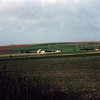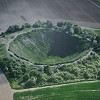Lochnagar Mine
Lochnagar mine was an explosive-packed mine created by the Royal Engineer tunnelling companies, located south of the village of La Boisselle in the Somme departement of France, which was detonated at 7:28 am on 1 July 1916, the first day of the Battle of the Somme. The Lochnagar mine, along with a neighbouring mine north of the village known as the Y Sap mine, contained 24 tons of ammonal. At the time these mines were the largest ever detonated.
The explosion was witnessed from the air by 2nd Lieutenant C.A. Lewis of No. 3 Squadron RFC:
The whole earth heaved and flashed, a tremendous and magnificent column rose up in the sky. There was an ear-splitting roar drowning all the guns, flinging the machine sideways in the repercussing air. The earth column rose higher and higher to almost 4,000 feet. There it hung, or seemed to hang, for a moment in the air, like the silhouette of some great cypress tree, then fell away in a widening cone of dust and debris.
Some of the British infantry waiting in no man's land were struck by falling debris and one man, having braced himself in a trench, had his leg broken and later required amputation.
The Lochnagar mine lay on the sector assaulted by the Grimsby Chums Pals battalion (10th Battalion, The Lincolnshire Regiment). When the main attack began at 7:30 am, the Grimsby Chums successfully occupied the crater and began to fortify the eastern lip which now dominated the surrounding ground. However, elsewhere the attack at La Boisselle went badly and infantry men sought shelter in the crater, particulary those who had been attacking up Sausage Valley to the south of the village. The prominent crater drew fire, including from British artillery, although eventually it was learned the crater contained sheltering infantry and the British ceased fire.
Memorial
The Lochnagar crater still exists today. Early attempts to fill it in were resisted and the land was eventually purchased by Richard Dunning to ensure it would be preserved. The Lochnagar memorial and a cross made with wood from Tyneside now mark the site.














